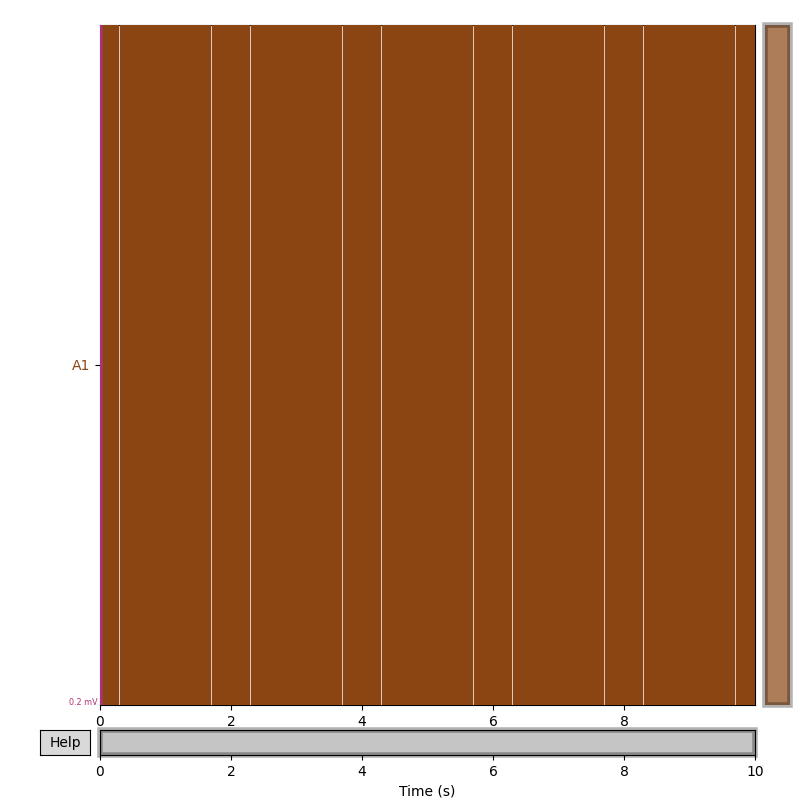Note
Go to the end to download the full example code
01. Detect HFOs in Simulated Dataset#
MNE-HFO currently depends on the data structures defined by MNE-Python.
Namely the mne.io.Raw object.
In this example, we use MNE-HFO to simulate raw data and detect HFOs. Specifically, we will follow these steps:
Create some simulated data and artificially simulate a few HFOs
Run a few
mne_hfo.base.Detectorinstances to detect HFOsFormat the detected HFOs as a
pandas.DataFrameWrite to disk and read it in again.
# Authors: Adam Li <adam2392@gmail.com>
#
We are importing everything we need for this example:
import numpy as np
from mne import create_info
from mne.io import RawArray
from mne_hfo import (RMSDetector, compute_chs_hfo_rates)
from mne_hfo.simulate import simulate_hfo
Simulate the data#
First, we need some data to work with. We will use a fake dataset that we simulate.
In this example, we will simulate sinusoidal data that has an artificial HFO added at two points with 9 cycles each.
# simulate the testing dataset
freqs = [2.5, 6.0, 10.0, 16.0, 32.5, 67.5, 165.0,
250.0, 425.0, 500.0, 800.0, 1500.0]
# sampling frequency
sfreq = 2000
# number of seconds to simulate
n = sfreq * 10
data = np.zeros(n)
# generate some sinusoidal data at specified frequencies
x = np.arange(n)
for freq in freqs:
# freq_amp = basic_amp / freq
y = np.sin(2 * np.pi * freq * x / sfreq)
data += y
# We have dummy data now inject 2 HFOs
freq = 250
numcycles = 9
sim = simulate_hfo(sfreq, freq, numcycles)[0]
ev_start = sfreq
data[ev_start: ev_start + len(sim)] += sim * 10
sim = simulate_hfo(sfreq, freq, numcycles)[0]
ev_start = 7 * sfreq
data[ev_start: ev_start + len(sim)] += sim * 10
# convert the data into mne-python
# note: the channel names are made up and the channel types are just
# set to 'seeg' for the sake of the example
ch_names = ['A1']
info = create_info(sfreq=sfreq, ch_names=ch_names, ch_types='seeg')
raw = RawArray(data=data[np.newaxis, :], info=info)
Creating RawArray with float64 data, n_channels=1, n_times=20000
Range : 0 ... 19999 = 0.000 ... 9.999 secs
Ready.
Let’s plot the data and see what it looks like
raw.plot()

Using matplotlib as 2D backend.
Detect HFOs#
All detectors inherit from the base class mne_hfo.base.Detector,
which inherits from the sklearn.base.BaseEstimator class.
To run any estimator, one instantiates it along with the hyper-parameters,
and then calls the fit function. Afterwards, detected HFOs are available
in the various data structures. The recommended usage is the DataFrame, which
is accessible via the mne_hfo.base.Detector.to_data_frame property.
kwargs = {
'threshold': 3, # threshold for "significance"
'win_size': 100, # window size in samples
'overlap': 0.25 # overlap in percentage relative to the window size
}
detector = RMSDetector(**kwargs)
# run detector
detector.fit(X=raw)
# show all the HFO annotations
print(detector.hfo_annotations)
# get the dataframe of the Annotations
df = detector.to_data_frame()
print(df.head())
0%| | 0/1 [00:00<?, ?it/s]
100%|██████████| 1/1 [00:00<00:00, 53.78it/s]
<Annotations | 2 segments, channel-specific: hfo (2)>
onset ... ch_names
0 1970-01-01 00:00:01 ... (A1,)
1 1970-01-01 00:00:07 ... (A1,)
[2 rows x 4 columns]
Convert HFO events to annotations#
Detectors output HFO events detected as a DataFrame fashioned after the
*_events.tsv files in BIDS-iEEG. Instead, HFO events are indeed
Derivatives of the Raw data, that are estimated/detected using mne-hfo.
The correct way to store them is in terms of an *_annotations.tsv,
according to the BIDS-Derivatives specification.
# convert to annotation df
annot_df = detector.to_data_frame(format='bids')
print(annot_df.head())
onset ... sfreq
0 1.0 ... 2000.0
1 7.0 ... 2000.0
[2 rows x 6 columns]
onset ... sfreq
0 1.0 ... 2000.0
1 7.0 ... 2000.0
[2 rows x 6 columns]
compute HFO rate as HFOs per second
ch_rates = compute_chs_hfo_rates(annot_df=annot_df, rate='s')
print(ch_rates)
Beginning timestamp: 2023-09-21 21:30:27.613463+00:00
Got end timestamp of: 2023-09-21 21:30:34.613463+00:00
Found HFO rate per s for A1 as 0.2857142857142857
defaultdict(<class 'list'>, {'A1': 0.2857142857142857})
Total running time of the script: (0 minutes 4.236 seconds)
Estimated memory usage: 181 MB